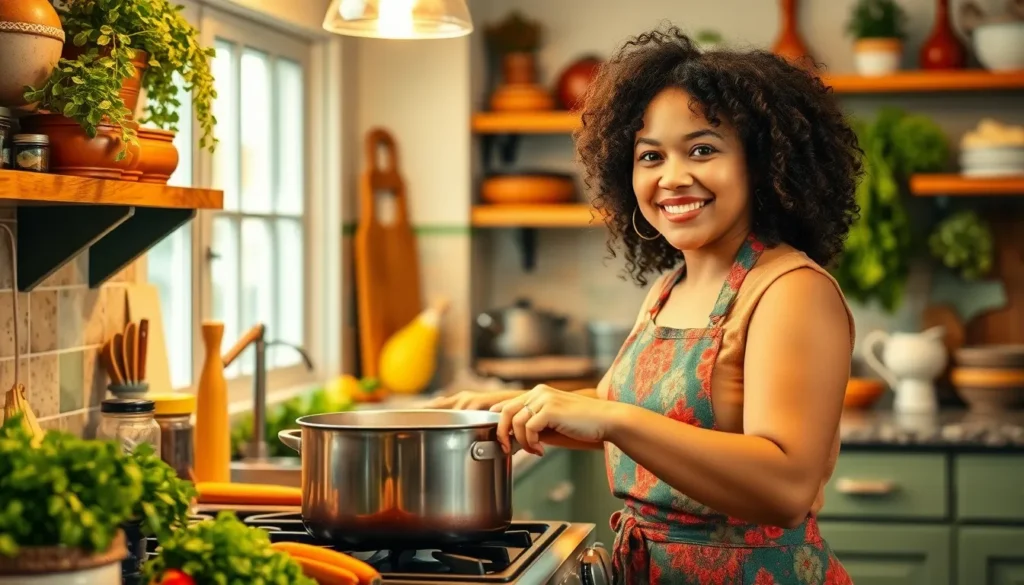Table of Contents
ToggleNillobada, the culinary sensation that’s taken the internet by storm, has everyone asking: can this gourmet guru whip up a feast at home? Picture this: a kitchen filled with laughter, the tantalizing aroma of spices wafting through the air, and a dash of chaos as Nillobada attempts to juggle pots and pans like a circus performer.
Understanding Nillobada
Nillobada stands out in the culinary world, captivating audiences with unique cooking techniques and flavors. Their approach to food combines tradition with creativity, making them a prominent figure in home kitchens.
What Is Nillobada?
Nillobada represents a dynamic culinary persona, known for innovative recipes that blend diverse ingredients. This cooking style emphasizes freshness, bold flavors, and artistic presentation. Home cooks often seek inspiration through Nillobada’s online channels, where they share practical tips and engaging content. Each dish tells a story, inviting everyone to explore the joy of home cooking.
Cultural Significance of Nillobada
Nillobada reflects rich cultural traditions, offering insights into culinary heritage. Recipes often connect to regional customs and seasonal ingredients. As people attempt to recreate these dishes, they foster community and share cultural experiences. This phenomenon encourages conversations around food’s role in our lives, blending personal and communal narratives. In society, Nillobada showcases the importance of preserving cultural identity through cooking.
Cooking Nillobada at Home

Cooking Nillobada at home creates an exciting culinary adventure. Engaging with unique techniques and flavors enhances the overall experience.
Ingredients Needed
Fresh ingredients play a vital role in Nillobada’s recipes. Essential items include seasonal vegetables, aromatic herbs, and high-quality proteins. Spices like cumin, coriander, and chili powder add depth to dishes. Olive oil or ghee contributes richness. Cooking equipment such as pots, pans, and knives is necessary to ensure a smooth process. Gather measuring spoons and cups to maintain precise ingredient ratios. Locations should inspire creativity through local markets, including farmers’ markets or specialty shops. Connecting with the community while sourcing ingredients elevates the cooking experience.
Step-by-Step Cooking Process
Begin by prepping all ingredients. Chopping vegetables and marinating proteins sets the stage. Choose a suitable cooking method based on the recipe, such as sautéing, boiling, or roasting. Heat oil in a pan before adding spices to release their aromas. Combine vegetables and proteins, stirring frequently to avoid sticking. Cook until everything reaches the desired doneness. Serve in visually appealing arrangements to showcase the artistic side of the dish. Invite friends or family to share in the joy of the finished meal, reinforcing the warmth and connection that cooking fosters.
Tips for Successful Nillobada
Success in cooking Nillobada dishes hinges on a few key techniques and mindful practices. These tips provide guidance to navigate the culinary journey effectively.
Common Mistakes to Avoid
Avoiding common mistakes greatly impacts the outcome. Misjudging ingredient measurements can lead to imbalanced flavors. Not prepping ingredients in advance often results in confusion during cooking. Overcooking vegetables diminishes their vibrant colors and nutritional value. Ignoring the importance of seasoning might leave dishes bland and uninviting. Lastly, neglecting presentation can detract from the overall dining experience.
Enhancing Flavor and Presentation
Enhancing flavor and presentation elevates Nillobada’s dishes. Using fresh, seasonal ingredients ensures maximum taste and vibrancy. Incorporating aromatic herbs like basil or thyme adds depth to the recipes. Presenting dishes with artistic plating engages the eyes as much as the palate. Dressing meals with colorful garnishes or sauces creates visual appeal. Experimenting with cooking techniques, such as grilling or caramelizing, enriches flavors significantly. Engaging with unique serving methods, like family-style platters, fosters a warm atmosphere around the dining table.
Alternative Cooking Methods
Exploring different cooking methods enhances the Nillobada experience at home. Each technique brings unique flavors and presentations to dishes.
Oven-Baking vs. Stovetop Cooking
Oven-baking creates an even cooking environment, ideal for roasting vegetables and proteins. It allows flavors to intensify and develop a rich texture. Stovetop cooking offers quick results, perfect for sautéing and stir-frying, where high heat seals in freshness. Chefs appreciate the control over temperature and timing with stovetop methods. Each technique complements various recipes, meaning home cooks can choose based on desired outcomes.
Using a Slow Cooker
A slow cooker excels at melding flavors over time, making it ideal for stews and braises. This method requires minimal active involvement, freeing up time for other tasks. With a slow cooker, ingredients simmer gently, developing depth in flavor. Many find that this hands-off approach retains moisture while creating tender dishes. Home cooks can experiment with seasonal ingredients, enhancing traditional Nillobada dishes creatively. This method encourages experimentation and flexibility in the kitchen.
Cooking Nillobada’s dishes at home is an adventure that inspires creativity and connection. With a blend of unique techniques and vibrant flavors it’s an opportunity to explore culinary traditions while experimenting with fresh ingredients. The joy of preparing meals and sharing them with loved ones fosters a sense of community and warmth.
By embracing the tips and techniques outlined, home cooks can elevate their culinary skills and enjoy the process. Nillobada’s innovative approach to cooking encourages everyone to dive into their kitchens with confidence and excitement. Ultimately it’s about creating memorable experiences through food that reflect personal and cultural stories.




